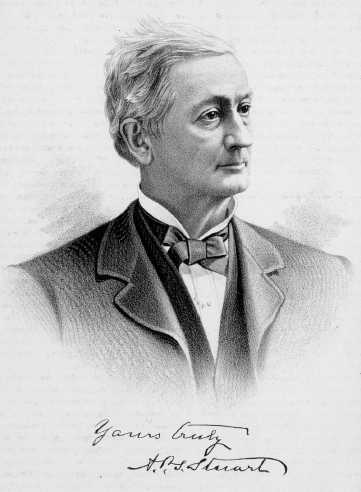during the winter season, thus
partly defraying the expenses of his education. After
graduation Prof. Stuart received an appointment in
Acadia College, Nova Scotia, where he taught
successfully two years, going from there to
Providence, R. I., where he remained until 1852, as
Principal of the Elm street grammar school. The
following two years our subject spent in Danvers,
Mass., having been selected as Principal of the Holten
High School.
In the fall of 1853 he returned to
Nova Scotia, and was again connected with Acadia
College, remaining as one of its faculty until 1858.
In June of that year, being desirous of perfecting his
knowledge of the sciences, Prof. Stuart went to Europe
and attended the universities of Heidelberg and
Gottingen, making a special study of chemistry. During
the three years that he was absent from home he
visited Italy, Switzerland, Holland, Belgium, France,
England and Scotland, and returning home in 1861,
arrived in New York soon after the battle of Bull Run.
In 1862 he accepted a position in the academy at
Worcester, Mass, which he retained until 1865, when he
was appointed Assistant Instructor of Chemistry in the
Lawrence Scientific School at Harvard College,
Cambridge, Mass. After his acceptance of this position
our subject was called to Brown's University, but did
not feel at liberty to accept, being already engaged
at Harvard College, where he remained until 1868, when
he resigned to accept the Chair of Chemistry in the
Pennsylvania Agricultural College. Soon afterward the
Professor was offered the Chair of Chemistry at the
Illinois State University, at Champaign, which he
accepted. He organized the chemical department of that
institution, and remained there for six years as
Professor, when he resigned and took a vacation for
one year. At the time of his father's death, in the
spring of 1875, our subject was selected to administer
upon his estate, and in December of that year he came
to Lincoln, and has been a resident here the greater
part of the time since. With characteristic energy he
at once identified himself with the best interests of
the city, and has been a potent factor in assisting
its marvelous growth. He has bought real estate and
erected a handsome dwelling, where he now resides.
Prof. Stuart has fine business
talent, and is as great a financier as he is
scientist, and is a Director in the Capitol National
Batik of Lincoln. He is well acquainted with the
topography of his native country, having visited
nearly every section of it, and has crossed the
Atlantic Ocean to Europe three times, his second visit
having been made in 1867, when he visited the World's
Exposition at Paris. In 1874 he made another trip to
Europe, visiting the principal cities of England and
the continent, in the interest of the Illinois
University, buying books and apparatus for its
chemical department.
Among his literary brethren Prof.
Stuart holds a high position, and is a fellow of the
American Association for the advancement of science,
and corresponding member of the New York Academy of
Science, besides being a member of the German Chemical
Society of Berlin.
Prof. Stuart has been twice married.
The maiden name of his first wife, to whom he was
united in marriage in 1849, was Mary Wheeler. She was
a native of Rhode Island and died in 1850, her married
life having been of brief duration. Our subject was
again married, June 6, 1876, taking for a wife Miss
Martha E. Downing, a native of Kennebunk, Me. She is
of English extraction, her grandfather, John Downing,
a native of England, having emigrated to America
accompanied by his brother George. The latter soon
returned to his native country, but the former settled
in Kennebunk. where he took up a tract of timbered
land, from which he cleared a farm, and there spent
the remainder of his years. After becoming settled in
life, he married Miss Mary Clarke, a daughter of Adam
Clarke, who was a native of England, and emigrated
with his family to America. He held an office under
the King, and had charge of the town records. Samuel
Downing, the father of Mrs. Stuart, was born, reared,
and spent his entire life in Kennebunk, dying in 1871.
He owned a farm which he carried on, and was also
extensively engaged in getting out ship timber. The
maiden name of his wife, the mother of Mrs. Stuart,
was Rachel Tarbox, daughter of James and Keziah
(Hooper) Tarbox. She died at the old homestead in
Maine. Mrs. Stuart is a member of the Methodist
Episcopal Church, as were her parents also.
Prof. Stuart is, and always has
been, a stanch Re-
|


